Text

Sarah Burnee. Hir Mark.
Nipmuc. Her homelands and homeplace at Hassanamesit, in present-day Grafton, Massachusetts. Sarah was daughter of Sarah Muckamaug and Fortune Burnee (Nipmuc and Black, respectively), and granddaughter of Peter Muckamaug.
In this quitclaim document, Sarah’s brother, Joseph Aaron, is deeding to her, for the sum “one hundred and twenty pounds of lawful money,” a portion of land at Hassanamesit.
The Muckamaug family was subject to much surveillance by the colonial government of Massachusetts, related specifically to Muckamaug land as Hassanamesit. Information, written by Sophia Ramos (Nipmuc) in the catalog record for the collection that this document comes from, states that “Sarah Muckamug[‘s].... union with an enslaved man called Aaron Whipple would create a decades-long investigation into her relationship in order to contest two of her children's - Sarah Burnee, who was born from...Fortune Burnee; and Joseph Aaron, who was the son of Aaron Whipple and born out of wedlock - claims to her inheritance.” We can read “inheritance” here to mean land, desired by the State.
Signed June 4, 1771.
Seen at the American Antiquarian Society.
#sarahburnee#muckamaug#hassanamesit#hassanamisco#nipmuc#theirmarks#easternwoodlands#nativehistory#18thcentury#18c#massachusetts#grafton#americanantiquariansociety
1 note
·
View note
Text

Craine. His mark and seal
Mohawk. One of many signers of this document representing Mohawk homelands that spread across areas known today as eastern New York State, parts of western Vermont and parts of southern Ontario and Quebec.
The Mohawk signers here outline an agreement to transfer land at the site of Fort Hunter west of so-called Albany, New York. Fort Hunter was constructed several years prior to the 1714 date of this deed, built by colonizers at the mouth of the Schoharie Creek, on the Mohawk River. Craine and others identify themselves as representatives of “we the three Races or Tribes of the Mohaugs Indians the Turtle, Wolf & B[ea]r.”
Signed in “Mohaughs Cuntry” May 14, 1716. Seen at Chapin Special Collections Library, Williams College.
#craine#mohawk#haudenosaunee#theirmarks#easternwoodlands#nativehistory#18thcentury#18c#newyork#williamscollege#forthunter
1 note
·
View note
Text

Cornelius Ind. his mark & seal
Mohawk. One of many signers of this document representing Mohawk homelands that spread across areas known today as eastern New York State, parts of western Vermont and parts of southern Ontario and Quebec
Cornelius is Identified within the text of this document as “Cornelius the Indian the youngest,” and appears alongside seven other Mohawk signers, who agreed to transfer land at the site of Fort Hunter west of so-called Albany, New York. Fort Hunter was constructed several years prior to the 1714 date of this deed, built by colonizers at the mouth of the Schoharie Creek, on the Mohawk River. Cornelius and others sign with pictographs and identify themselves as representatives of “we the three Races or Tribes of the Mohaugs Indians the Turtle, Wolf & B[ea]r.”
Signed in “Mohaughs Cuntry” May 14, 1716. Seen at Chapin Special Collections Library, Williams College.
#cornelius#mohawk#Haudenosaunee#theirmarks#easternwoodlands#nativehistory#18thcentury#18c#newyork#williamscollege#forthunter
3 notes
·
View notes
Text

The mark of Uppehchihtuk
Nipmuc. Perhaps of Wabbaquasset, Chaubunagungamog or Magunkaquog. Again, we’ve yet uncovered little-to-no additional information about Uppehchihtuk to be able to further contextualize their life. If you know more, feel free to share in the comments!
This document, signed by Uppehchihtuk, Wuttasacomponom, Job Kattenanit and others, reports to be submitted on behalf of “peoples of Nipmuck…the inhabitants of Quánutusset, Mônuhčhogok, Chaubunakongkomuk, Asukodnôcog, Kesépusqus, wabuhqushish and the adjacent parts of Nipmuk…” It pledges the submission of inhabitants of praying towns to the government of Massachusetts. It’s signed in 1668, a little less than a decade before the War would begin.
Seen at the Massachusetts State Archives.
#uppehchihtuk#nipmuc#theirmarks#easternwoodlands#nativehistory#17thcentury#17c#massachusetts#massstatearchives#algonquian
1 note
·
View note
Text
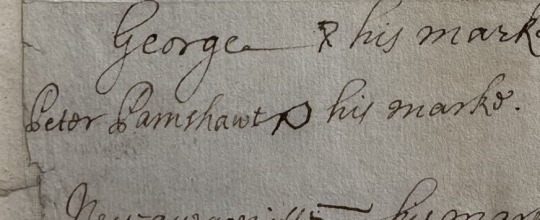
Peter Pamshawt his marke.
Presumably Wampanoag and kin to Awashonks, whose homelands at Sakonnet include the place today called “Little Compton, Rhode Island.”
Peter Pamshawt’s name appears here alongside many others as co-signatories to a document dated May 23, 1674. The document, principally signed by Awashonks, details the dispossession of land from Sakonnet to white settlers.
So far, we’ve uncovered little-to-no additional information about Peter Pamshawt to be able to further contextualize his life. If you know more, feel free to share in the comments!
#peterpamshawt#pamshawt#sakonnet#wampanoag#awashonks#hismarke#theirmarks#easternwoodlands#nativehistory#17thcentury#17c#rhodeisland#masshistorical#algonquian#kingphilipswar
1 note
·
View note
Text

The marke of Tasomockon (Tuspaquin)
Wampanoag. Their homelands at Nemasket and Assawompset (in the areas today called “Middleboro” and “Lakeville, Massachusetts”).Their mark appearing here on a document dated 1651, and signed also by Ousamequin, the Massasoit, and Ousamequin’s son, Wamsutta (later also called Alexander).
Tuspaquin’s kin: son of Pamontaquask. A partner, Amie (daughter of Ousamequin), their sons, Benjamin and Wiliam Tuspaquin.
This is our second post on Tuspaquin, whose mark is different across the two documents (dated 1651 and 1664) we’ve so far explored.
Seen at Massachusetts State Archives.
#tuspaquin#sachem#wampanoag#nemasket#assawompset#massachusetts#theirmarks#17thcentury#17c#massstatearchives#algonquian#easternwoodlands#nativehistory
17 notes
·
View notes
Text

The marke of Josiah ye Sachem (Josias Chikatabut).
Also known as Josias Wampatuck and Josias Sagamore. Massachusett sachem at Mattakeesett, land at and near the place today called Quincy, Massachusetts. In this document, dated June 14, 1667, Josias Chikatabut is identified as “Sachem of the Massachusets Indians” and asks that the town of Dorchester “would give him a deed of gift, of that six thousand acres at punkopauog [sic] which the town gave to the Indians.”
Josias Chickatabut’s kin: father, Obtakiest or Chickatabut; children called Jeremy, Abigail, and Charles Wampatuck.
Translated from the Algonquian, Wompatuck may mean white deer, or snow goose. Chickataubut may mean thankful fire. We’d love to hear your thoughts in the comments!
Seen at the Massachusetts State Archives.
#theirmarks#17thcentury#algonquian#massachusett#chickatabut#josiaswompatuck#mattakeeset#easternwoodlands#nativehistory#massachusetts#sachem#sagamore#17c#ponkapoag
1 note
·
View note
Text

The Mark of Wutasakompanin.
Nipmuc. Also known as Captain Tom or Tom Wuttasacomponom. A Christian convert at Hassanamesit. Vowed loyalty to settlers during the First Indian War, or King Philip's War, but was still hung by colonizers in 1676 after accusations of being involved in the burnings of Sudbury and Medfield (which Wuttasacomponom denied).
This document, signed by Wuttasacomponom and others, reports to be submitted on behalf of “peoples of Nipmuck…the inhabitants of Quánutusset, Mônuhčhogok, Chaubunakongkomuk, Asukodnôcog, Kesépusqus, wabuhqushish and the adjacent parts of Nipmuk…” It pledges the submission of inhabitants of praying towns to the government of Massachusetts. It’s signed in 1668, a little less than a decade before the War would begin.
Below Wuttasacomponom’s mark is the signature of Job Kattenanit, brother of James Printer, whom we will write about at a later date.
Wuttasaompnoms kin: a son, Nehemiah Tom.
Seen at the Massachusetts State Archives.
#wutasakompanin#wuttasacomponom#nipmuc#hassanamesit#wabaquasset#theirmarks#easternwoodlands#nativehistory#17thcentury#17c#massachusetts#rhodeisland#masshistorical#algonquian
2 notes
·
View notes
Text
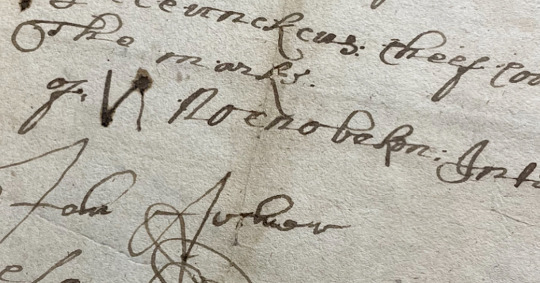
The marke of Noenobekon; interpreter
Possibly Pocasset Wampanoag or Narragansett. Identified on this deed, signed in June of 1660 as an interpreter for Namumpum (Weetamoo) and Quiquequonnechog, her then partner.
The document elucidates on access to land for white settlers, and includes place names for lands at and beyond Pocasset (present-day Little Compton, Rhode Island). Some place names are spelled here as they appear (or as well as I can decipher) as: “...a certain necke of land commonly called by ye name of Panaquaquit, popochocksset … chechoesit, wonascotucket, womposcocinnat…”
We have been hard pressed to find further information about Noenobekon, beyond what can be inferred from the document itself.
Dated June 1660, seen at the Massachusetts Historical Society
#pocasset#wampanoag#narragansett#noenobekon#weetamoo#namumpum#theirmarks#easternwoodlands#nativehistory#17thcentury#17c#massachusetts#rhodeisland#masshistorical#algonquian#littlecompton
1 note
·
View note
Text
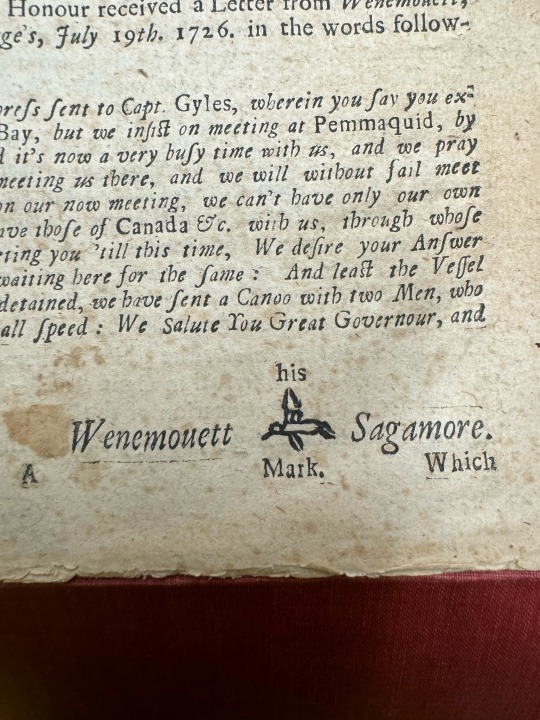
Wenemouett Sagamore. His Mark.
Penobscot. Sachem. Wenemouett’s homelands across the central parts of so-called “Maine.”
This mark, in print, appears on “The Conference with the Eastern Indians, at the Ratification of the Peace, held at Falmouth in Casco-Bay, in July and August, 1726.” Printed in Boston in 1726. This peace agreement between the Penobscot and English colonizers was signed amid tensions between Wabanaki nations and the French and English in Wabanaki territories.
This is the first time we are sharing a mark as it appears in a published source - meaning a piece of type was created from the mark and printed through a printing press to be reproduced many times for the publication. This differs from our usual share of a hand-written, pictograph mark on an original, or handwritten copy of an original manuscript document. The handwritten mark alongside the printed one would make an interesting comparison.
From “The Conference with the Eastern Indians, at the Ratification of the Peace, held at Falmouth in Casco-Bay, in July and August, 1726,” Boston, 1726. The copy shown is held at the John Carter Brown Library.
#wenemouett#penobscot#sachem#sagamore#theirmarks#18thcentury#18c#algonquian#easternwoodlands#nativehistory#maine#wabanaki#johncarterbrownlibrary
1 note
·
View note
Text

The mark of Zacharaiah Abram. (Zachary Abraham)
Natick Nipmuc. At home at Natick and Hassananamisco (present day Grafton, Massachusetts). One of a group of Natick converts to Christianity who translated for and informed the English during Metacom’s War or King Philip’s War. Here Abram’s mark appears, with other Nipmuc signers, on an agreement to the sale of land between Hassanamisco and Magunkaquog. Magunkaquog is the place now occupied by the present day towns lying between Grafton and Natick, including Ashland and Westborough.
Document is undated. Seen as Massachusetts State Archives.
#zacharyabraham#zachariahabram#nipmuc#hassanamisco#natick#magunkaquog#theirmarks#17thcentury#17c#algonquian#easternwoodlands#nativehistory#massachusetts#massstatearchives
0 notes
Text
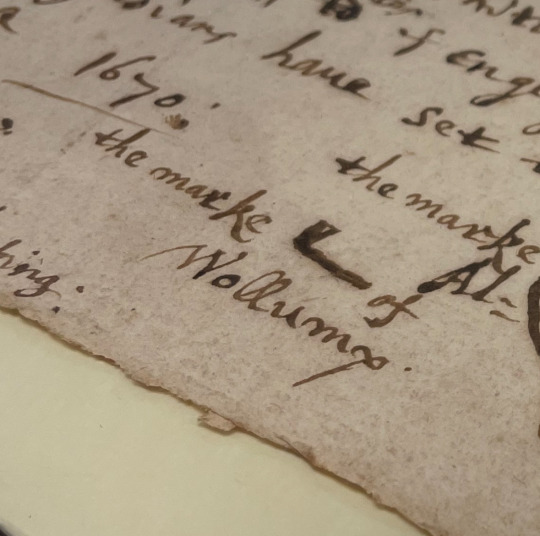
Wallump. Their Mark.
Nipmuc/Pocumtuc. A leader at Pojassic and Woronack, the areas in and surrounding so-called “Westfield, Massachusetts.” This document, signed April 25, 1670, details the exchange of 7 or 8 acres of meadow land for “...three acres of old ground for ye
Indians to Plant Corne on this yeare…” and five acres of land yearly thereafter. The land was to be “free from all fencings or payment of Rates to ye english…”
Kin: Alquat (father), also known as Keems, Sachem at Woronoke and Pojassic
This deed signed April 25, 1670. Seen at Springfield History Museum and Archives, Springfield, Ma.
#Wallump#Alquat#Nipmuc#Sachem#Pocumtuc#theirmarks#17thcentury#17c#Massachusetts#algonquian#easternwoodlands#nativehistory#sachem#westfield#massachusetts#woronoke#pojassic#springfieldhistorymuseum
1 note
·
View note
Text

The mark of Nahnanacomock.
Penacook. Their homelands along the Merrimack river, and at the places where the present-day boundaries of so-called “New Hampshire,” “Maine,” and “Massachusetts” exist. This document, signed June 12, 1644, is interpreted as a peace agreement, signed by Passaconaway and Nahnanacomock on behalf of the Pennacook, and the Massachusetts Bay Colony.
Nahnanacomock’s kin: one source suggests Nahnanacomock is the son of Passaconaway.
Seen at the Massachusetts State Archives.
#nahnanacomock#pennacook#theirmarks#easternwoodlands#nativehistory#sachem#17thcentury#massachusetts#newhampshiire#maine#merrimackriver#massstatearchives#algonquian
2 notes
·
View notes
Text

Pumham. Sachem of Showhomett Pumhomm.
Sachem at Shawomet, or so-called “Warwick, Rhode Island,” Pumham had an interesting and well documented relationship with both English colonizers and Narragansett relatives. Settlers in Warwick tried to arrest Pumham for an insurrection attempt in 1659 and later moved to expel Pumham from Shawomet altogether, in 1667. Pumham refused to leave and would remain in Shawomet until he was killed by settlers in July of 1676 while fighting with Pometacom in King Philip’s War.
In this document, Pomham signs as witness to a transfer of land “lyinge uppon the west syde of that part of the sea called Sowhanes Bay, from Copassanatuxett, over against a little island in the sayd bay, being the north bounds, and the outmost point that neck of land called Shawhomet…” signed by Miantonomo.
Their kin: at least two sons, one named Cheesechamut.
[Indian deed of Warwick, Rhode Island], 1642. Seen @ John Carter Brown Library.
#nahaganset#narragansett#pumham#miantonomo#theirmarks#easternwoodlands#nativehistory#sachem#17thcentury#rhodeisland#johncarterbrownlibrary#warwick#shawhomet#algonquian
0 notes
Text

James Achoogik. His mark.
Nipmuc. A Christian Indian living at Natick. So far little has been uncovered about the life of James Achoogik, but their mark appears here on a land transaction dated May 31, 1699. James Achoogik and more than a dozen other Christian Indian signers are agreeing to sell 200 acres of their plantation in Natick to fund repairs to their meetinghouse. They write: “…wee are now greatly deminished & impovereshed our meeting house where wee were wont constantly to meet …has fallen downe and we are not able to build us another…”
The meetinghouse was repaired, but no longer stands in Natick.
Seen at the Mass. State Archives.
#jamesachoogik#nipmuc#natick#massachusetts#theirmarks#17thcentury#17c#massstatearchives#algonquian#easternwoodlands#nativehistory
1 note
·
View note
Text
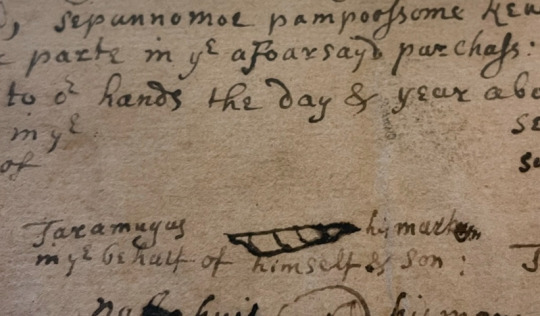
Tarramuggus. Turramuggas. Terramuggas. Taramugus his marke in ye behalf of himself & son.
Wangunk. Their homelands across and around Pattaqounck or Pattaconk, in the southern part of present day central Connecticut. This document describes a part of land now called Haddam, Connecticut, “ …from mattabesett mill river to ye lower end of pattaquounck meadow on both sides of ye [Kwinitekw] river.” The deed sets aside “Thirty mile Island & forty acres of land at pattaquounck which they [Wangunk] doe reserve…for them and their assignsf from ye day of ye date hereof forever without any interruption or molestation…”
Their kin: a father, Sowheage. A sister, Sepunnamo or Sepunnemoe. A partner, Keseso. A son, Peetoosoh.
Signed May 20, 1662. Seen at Mohegan Library and Archives.
#turramuggas#wangunk#pattaconk#connecticut#haddamconnecticut#mattabesett#theirmarks#17thcentury#17c#moheganlibraryandarchives#algonquian#easternwoodlands#nativehistory
2 notes
·
View notes
Text
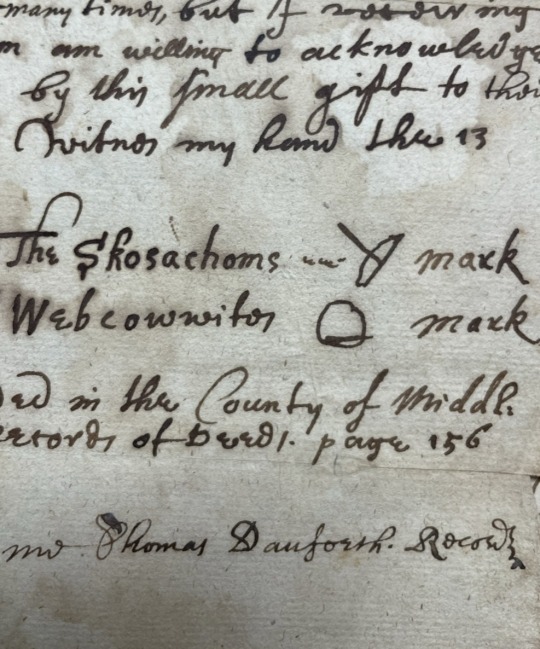

Webcowet. Webcowitt. Webcowwitos mark.
Massachusett. At home at the places that are today called Charlestown, Medford, Winchester, Massachusetts and surrounding areas. A pawau or spiritual leader, closely tied to the Sachem of Mistick after the death of her partner, Nanepashemet.
Photo 1: Land transfer marked in November 1636; the Sachem of Mistick references a tract of land “from Charlestown to Cambr[idge] which lays against the ponds at Mistick…”
Photo 2: The mark on this deed from April 15 1639. The deed describes land proximate to Charlestown, reserving lands along Mistick Pond for the Sachem of Mistick and her people to use for planting and hunting until her death.
Webcowitt’s Kin: Squaw Sachem of Mistick*
Seen at the Massachusetts Historical Society.
*In a previous post about the Sachem of Mistick we offered suggestions and information around the use of the term Squaw in the primary document and in subsequent references to the female sachem of Mistick. The term has been appropriated and the Algonquian word (and once honorific term) is now widely considered to be offensive and derogatory.
#webcowitt#mistick#massachusett#charlestown#cambridge#massachusetts#theirmarks#easternwoodlands#nativehistory#sachemofmistick#17thcentury#masshistoricalsociety#algonquian
1 note
·
View note